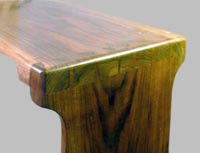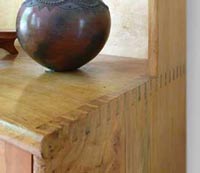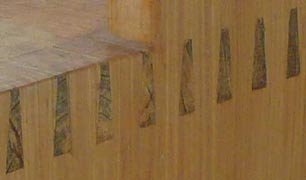|
Wood joinery
is the process of creating a physical interlocking shape at the joint
where two pieces of wood are held together. Dovetails are an example of
this, but there are many different types of joint design in wood
joinery. These designs were developed long ago when glues were
unreliable - they were not particularly strong and they were made from
natural material (hide-glue, for example) that was eaten by microbes
and fungus that over time that left the "glue joint" without any glue
and the two pieces of wood fell apart. Glues today are very strong and
last a long time.
However, all woods share a classic glueing characteristic
- glue sticks very well to the side-grain of wood, but does not stick
very well to the end-grain of wood. So, every wood joint is designed
with this in mind: maximize the side-grain contact of one piece with
the side-grain of the other piece.
All of the classic joint designs very effectively do this.
|
Below are some images of wood joinery work that we've built.

|
This is a typical dovetail joint design in Walnut. No glue would hold
these boards at right angles if they were simply butted together with
some glue. Interlocking these boards with dovetails not only maximizes
the amount of side-grain surface area contact between the two boards,
but creates a wedge-style interlocking joint that holds even without
glue. With glue in the joint, if the unit is put under stress the
boards themselves will break long before the joint comes apart.
|

|
This is another example of dovetail joinery, this time in Elm. This
joint is between two boards that are more than 24 inches wide. The
joint is exceedingly strong (like the example above) and it also allows
both boards to expand and contract across the grain over the course of
the year so no cracks or splits appear in the piece.
|

|
A closeup of the joint in the piece above. As you can see, because the
dovetails interlock, they create a pleasing visual pattern. Joint
designers long ago designed what is called a "blind dovetail" joint in
which a thin flap of wood is left on each board that covers the actual
joint of the board being joined to it, retaining the strength of the
dovetail joint, but the look of a miter joint in which the dovetails are masked by the flap. Just one of the many
different variations of joint design that maximizes side-grain to
side-grain contact between boards.
|

|
A closeup of another portion of the joint in the same piece.
|
|
|
|



